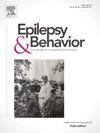Dravet syndrome: Insights into seizure and speech progression from registry data
IF 2.3
3区 医学
Q2 BEHAVIORAL SCIENCES
引用次数: 0
Abstract
Objective
Dravet syndrome (DS) is a rare genetic developmental and epileptic encephalopathy syndrome characterized by refractory seizures and neurodevelopmental disorders beginning in infancy. This study aims to understand the natural history of DS by utilizing longitudinal data from patient registries.
Methods
We analysed data from 475 subjects across two European patient registries (RESIDRAS and Platform-RESIDRAS) from Dravet Italia Onlus, collected between 2010 and 2024. The study included only participants that were under 18 years old. Clinical characteristics such as seizure types and speech development were modelled using generalized linear mixed models and ordinal transition models.
Results
Unilateral seizures predominantly occurred during infancy and early childhood, while generalized convulsive and focal to bilateral tonic-clonic seizures increased with age, showing a higher incidence in boys. Focal seizures peaked around the age of three years before declining. Speech development varied, with most participants initially having poor speech. However, a considerable number of transitions between different levels of speech impairment were observed over time. Transition models indicated that once speech is acquired, the likelihood of losing this ability is negligible.
Significance
Patient registries are instrumental in modelling the disease history of DS, offering insight into its progression by means of advanced statistical modelling techniques that build on clinical expertise. Future research should focus on evaluating the effects of therapies and exploring the interrelations between different clinical characteristics. Understanding these aspects can guide better management strategies and improve patient outcomes.
Dravet综合征:从注册数据中了解癫痫发作和语言进展
目的:dravet综合征(DS)是一种罕见的遗传性发育性癫痫性脑病综合征,以婴儿期开始的难治性癫痫发作和神经发育障碍为特征。本研究旨在通过利用患者登记的纵向数据来了解退行性椎体滑移的自然历史。方法:我们分析了2010年至2024年间收集的来自意大利draveet Onlus的两个欧洲患者登记处(RESIDRAS和平台-RESIDRAS) 475名受试者的数据。这项研究只包括了18岁以下的参与者。临床特征如癫痫发作类型和语言发展使用广义线性混合模型和有序过渡模型建模。结果患儿多发生于婴儿期和幼儿期,全身性惊厥和局灶性至双侧强直阵挛性发作随年龄增长而增加,其中男孩发病率较高。局灶性癫痫发作在三岁左右达到高峰,然后逐渐减少。语言发展各不相同,大多数参与者最初的语言能力很差。然而,随着时间的推移,在不同程度的语言障碍之间观察到相当数量的过渡。过渡模型表明,一旦获得了语言,失去这种能力的可能性可以忽略不计。患者登记有助于对退行性椎体滑移的病史进行建模,通过建立在临床专业知识基础上的先进统计建模技术,可以深入了解其进展。未来的研究应侧重于评价治疗效果和探索不同临床特征之间的相互关系。了解这些方面可以指导更好的管理策略并改善患者的治疗效果。
本文章由计算机程序翻译,如有差异,请以英文原文为准。
求助全文
约1分钟内获得全文
求助全文
来源期刊

Epilepsy & Behavior
医学-行为科学
CiteScore
5.40
自引率
15.40%
发文量
385
审稿时长
43 days
期刊介绍:
Epilepsy & Behavior is the fastest-growing international journal uniquely devoted to the rapid dissemination of the most current information available on the behavioral aspects of seizures and epilepsy.
Epilepsy & Behavior presents original peer-reviewed articles based on laboratory and clinical research. Topics are drawn from a variety of fields, including clinical neurology, neurosurgery, neuropsychiatry, neuropsychology, neurophysiology, neuropharmacology, and neuroimaging.
From September 2012 Epilepsy & Behavior stopped accepting Case Reports for publication in the journal. From this date authors who submit to Epilepsy & Behavior will be offered a transfer or asked to resubmit their Case Reports to its new sister journal, Epilepsy & Behavior Case Reports.
 求助内容:
求助内容: 应助结果提醒方式:
应助结果提醒方式:


